Comprehensive Auditing Report: Satyam Collapse, Issues, and Lessons
VerifiedAdded on 2022/10/11
|14
|3709
|13
Report
AI Summary
This report examines the Satyam Computer Services Limited scandal, often referred to as "India's Enron," which involved widespread accounting fraud. The assignment delves into the key auditing and accounting issues that arose during the collapse, including the lack of independence of directors, ethical failures, and the inadequate role of the audit committee. It analyzes how these factors contributed to the fraudulent activities, such as the overstatement of assets and manipulation of financial figures. The report further discusses the importance of non-Australian auditing scandals to Australian auditors, emphasizing the lessons that can be learned from cases like Satyam to strengthen corporate governance, improve audit practices, and prevent similar occurrences in the future. The analysis highlights the need for robust corporate governance, increased vigilance by companies and auditors, and the implementation of strong internal controls to ensure the integrity of financial reporting.
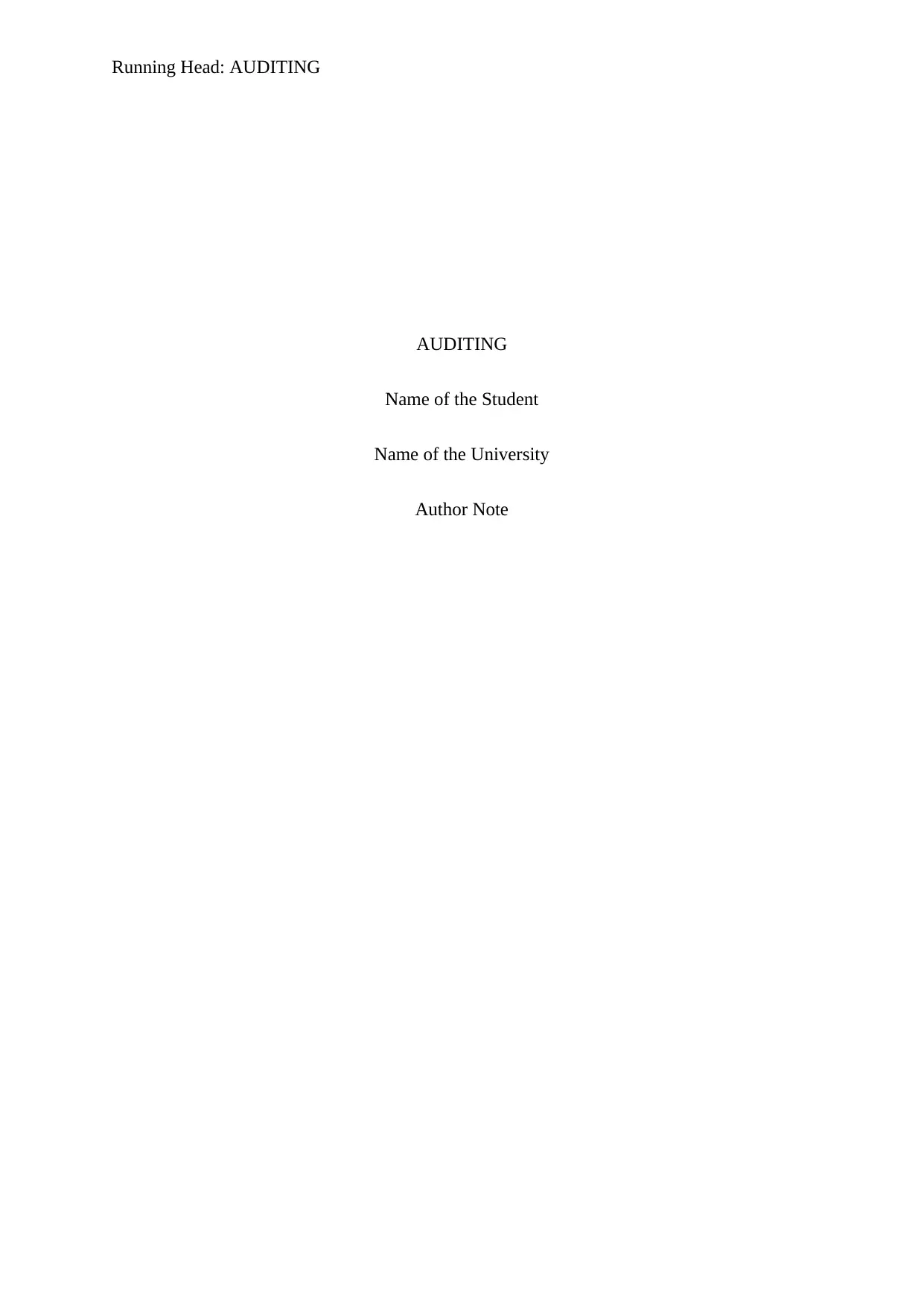
Running Head: AUDITING
AUDITING
Name of the Student
Name of the University
Author Note
AUDITING
Name of the Student
Name of the University
Author Note
Paraphrase This Document
Need a fresh take? Get an instant paraphrase of this document with our AI Paraphraser
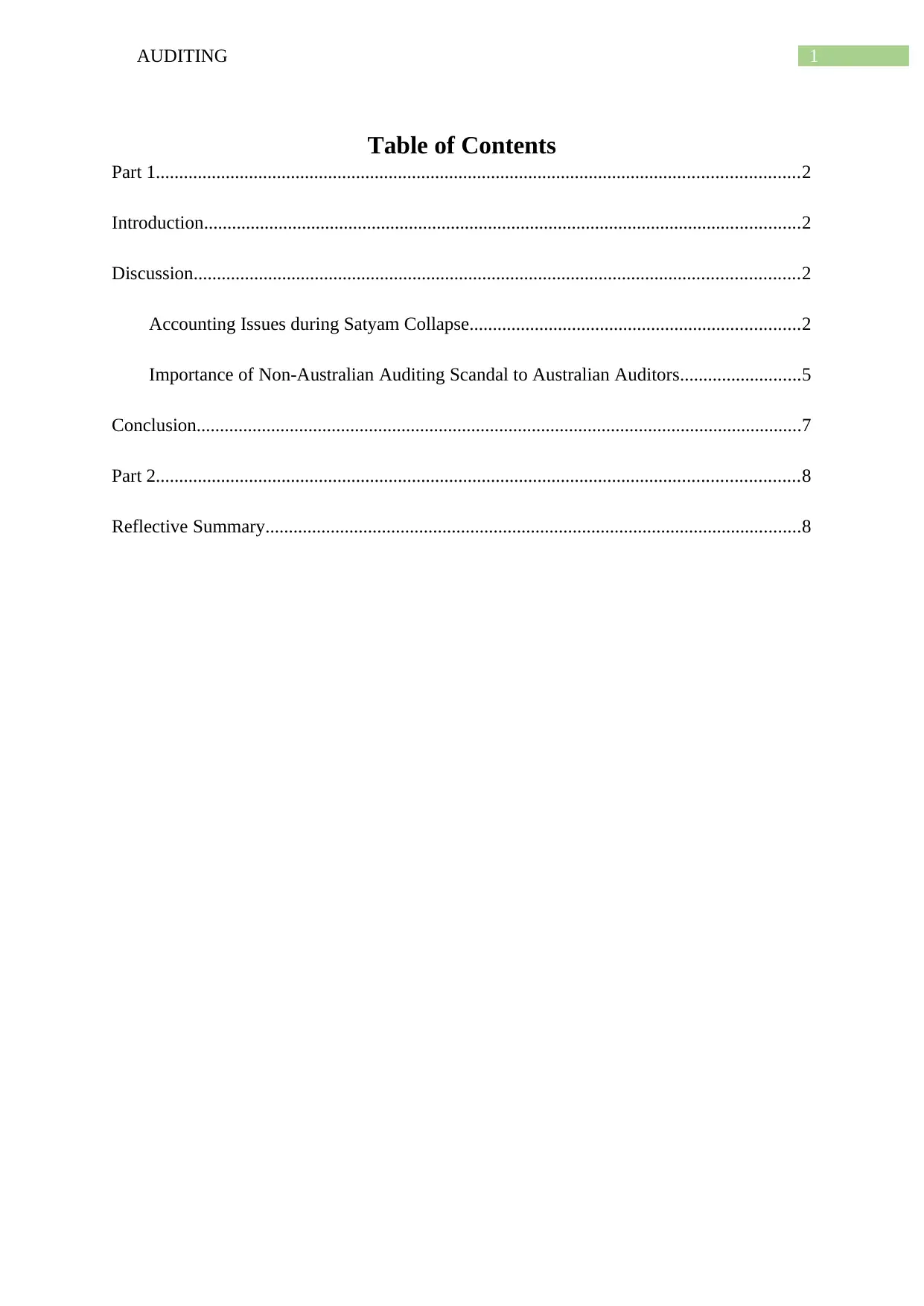
1AUDITING
Table of Contents
Part 1..........................................................................................................................................2
Introduction................................................................................................................................2
Discussion..................................................................................................................................2
Accounting Issues during Satyam Collapse.......................................................................2
Importance of Non-Australian Auditing Scandal to Australian Auditors..........................5
Conclusion..................................................................................................................................7
Part 2..........................................................................................................................................8
Reflective Summary...................................................................................................................8
Table of Contents
Part 1..........................................................................................................................................2
Introduction................................................................................................................................2
Discussion..................................................................................................................................2
Accounting Issues during Satyam Collapse.......................................................................2
Importance of Non-Australian Auditing Scandal to Australian Auditors..........................5
Conclusion..................................................................................................................................7
Part 2..........................................................................................................................................8
Reflective Summary...................................................................................................................8
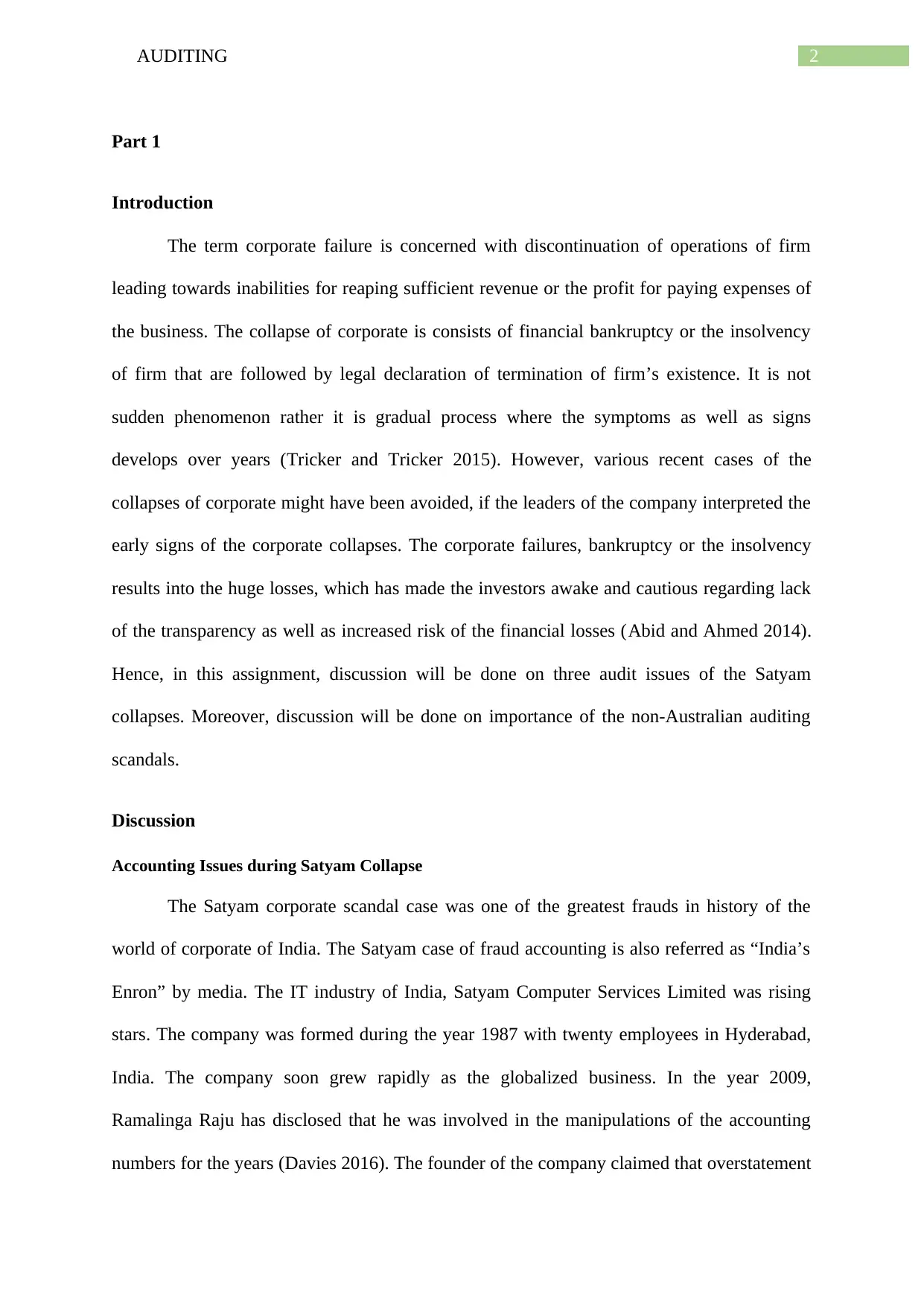
2AUDITING
Part 1
Introduction
The term corporate failure is concerned with discontinuation of operations of firm
leading towards inabilities for reaping sufficient revenue or the profit for paying expenses of
the business. The collapse of corporate is consists of financial bankruptcy or the insolvency
of firm that are followed by legal declaration of termination of firm’s existence. It is not
sudden phenomenon rather it is gradual process where the symptoms as well as signs
develops over years (Tricker and Tricker 2015). However, various recent cases of the
collapses of corporate might have been avoided, if the leaders of the company interpreted the
early signs of the corporate collapses. The corporate failures, bankruptcy or the insolvency
results into the huge losses, which has made the investors awake and cautious regarding lack
of the transparency as well as increased risk of the financial losses (Abid and Ahmed 2014).
Hence, in this assignment, discussion will be done on three audit issues of the Satyam
collapses. Moreover, discussion will be done on importance of the non-Australian auditing
scandals.
Discussion
Accounting Issues during Satyam Collapse
The Satyam corporate scandal case was one of the greatest frauds in history of the
world of corporate of India. The Satyam case of fraud accounting is also referred as “India’s
Enron” by media. The IT industry of India, Satyam Computer Services Limited was rising
stars. The company was formed during the year 1987 with twenty employees in Hyderabad,
India. The company soon grew rapidly as the globalized business. In the year 2009,
Ramalinga Raju has disclosed that he was involved in the manipulations of the accounting
numbers for the years (Davies 2016). The founder of the company claimed that overstatement
Part 1
Introduction
The term corporate failure is concerned with discontinuation of operations of firm
leading towards inabilities for reaping sufficient revenue or the profit for paying expenses of
the business. The collapse of corporate is consists of financial bankruptcy or the insolvency
of firm that are followed by legal declaration of termination of firm’s existence. It is not
sudden phenomenon rather it is gradual process where the symptoms as well as signs
develops over years (Tricker and Tricker 2015). However, various recent cases of the
collapses of corporate might have been avoided, if the leaders of the company interpreted the
early signs of the corporate collapses. The corporate failures, bankruptcy or the insolvency
results into the huge losses, which has made the investors awake and cautious regarding lack
of the transparency as well as increased risk of the financial losses (Abid and Ahmed 2014).
Hence, in this assignment, discussion will be done on three audit issues of the Satyam
collapses. Moreover, discussion will be done on importance of the non-Australian auditing
scandals.
Discussion
Accounting Issues during Satyam Collapse
The Satyam corporate scandal case was one of the greatest frauds in history of the
world of corporate of India. The Satyam case of fraud accounting is also referred as “India’s
Enron” by media. The IT industry of India, Satyam Computer Services Limited was rising
stars. The company was formed during the year 1987 with twenty employees in Hyderabad,
India. The company soon grew rapidly as the globalized business. In the year 2009,
Ramalinga Raju has disclosed that he was involved in the manipulations of the accounting
numbers for the years (Davies 2016). The founder of the company claimed that overstatement
⊘ This is a preview!⊘
Do you want full access?
Subscribe today to unlock all pages.

Trusted by 1+ million students worldwide
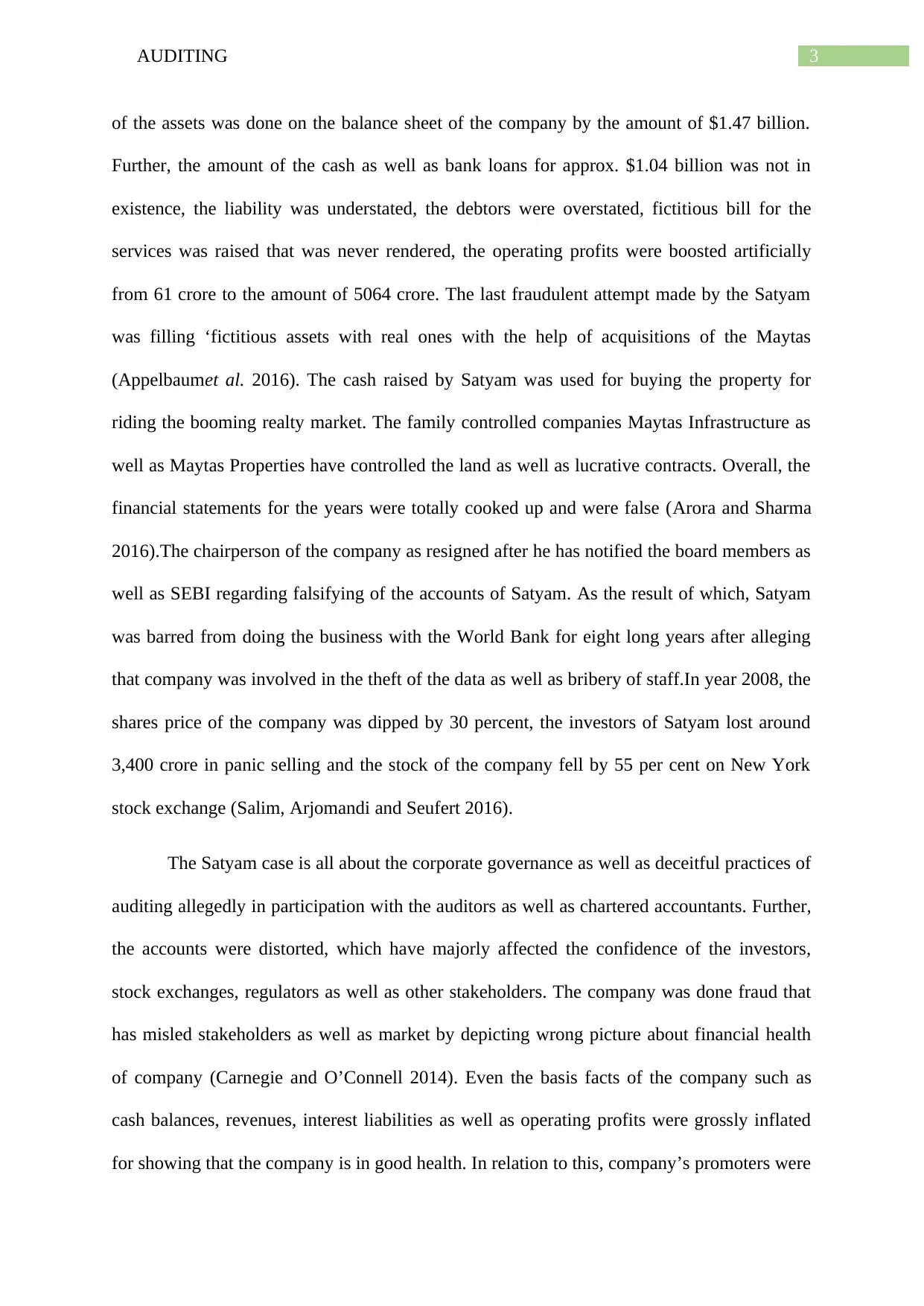
3AUDITING
of the assets was done on the balance sheet of the company by the amount of $1.47 billion.
Further, the amount of the cash as well as bank loans for approx. $1.04 billion was not in
existence, the liability was understated, the debtors were overstated, fictitious bill for the
services was raised that was never rendered, the operating profits were boosted artificially
from 61 crore to the amount of 5064 crore. The last fraudulent attempt made by the Satyam
was filling ‘fictitious assets with real ones with the help of acquisitions of the Maytas
(Appelbaumet al. 2016). The cash raised by Satyam was used for buying the property for
riding the booming realty market. The family controlled companies Maytas Infrastructure as
well as Maytas Properties have controlled the land as well as lucrative contracts. Overall, the
financial statements for the years were totally cooked up and were false (Arora and Sharma
2016).The chairperson of the company as resigned after he has notified the board members as
well as SEBI regarding falsifying of the accounts of Satyam. As the result of which, Satyam
was barred from doing the business with the World Bank for eight long years after alleging
that company was involved in the theft of the data as well as bribery of staff.In year 2008, the
shares price of the company was dipped by 30 percent, the investors of Satyam lost around
3,400 crore in panic selling and the stock of the company fell by 55 per cent on New York
stock exchange (Salim, Arjomandi and Seufert 2016).
The Satyam case is all about the corporate governance as well as deceitful practices of
auditing allegedly in participation with the auditors as well as chartered accountants. Further,
the accounts were distorted, which have majorly affected the confidence of the investors,
stock exchanges, regulators as well as other stakeholders. The company was done fraud that
has misled stakeholders as well as market by depicting wrong picture about financial health
of company (Carnegie and O’Connell 2014). Even the basis facts of the company such as
cash balances, revenues, interest liabilities as well as operating profits were grossly inflated
for showing that the company is in good health. In relation to this, company’s promoters were
of the assets was done on the balance sheet of the company by the amount of $1.47 billion.
Further, the amount of the cash as well as bank loans for approx. $1.04 billion was not in
existence, the liability was understated, the debtors were overstated, fictitious bill for the
services was raised that was never rendered, the operating profits were boosted artificially
from 61 crore to the amount of 5064 crore. The last fraudulent attempt made by the Satyam
was filling ‘fictitious assets with real ones with the help of acquisitions of the Maytas
(Appelbaumet al. 2016). The cash raised by Satyam was used for buying the property for
riding the booming realty market. The family controlled companies Maytas Infrastructure as
well as Maytas Properties have controlled the land as well as lucrative contracts. Overall, the
financial statements for the years were totally cooked up and were false (Arora and Sharma
2016).The chairperson of the company as resigned after he has notified the board members as
well as SEBI regarding falsifying of the accounts of Satyam. As the result of which, Satyam
was barred from doing the business with the World Bank for eight long years after alleging
that company was involved in the theft of the data as well as bribery of staff.In year 2008, the
shares price of the company was dipped by 30 percent, the investors of Satyam lost around
3,400 crore in panic selling and the stock of the company fell by 55 per cent on New York
stock exchange (Salim, Arjomandi and Seufert 2016).
The Satyam case is all about the corporate governance as well as deceitful practices of
auditing allegedly in participation with the auditors as well as chartered accountants. Further,
the accounts were distorted, which have majorly affected the confidence of the investors,
stock exchanges, regulators as well as other stakeholders. The company was done fraud that
has misled stakeholders as well as market by depicting wrong picture about financial health
of company (Carnegie and O’Connell 2014). Even the basis facts of the company such as
cash balances, revenues, interest liabilities as well as operating profits were grossly inflated
for showing that the company is in good health. In relation to this, company’s promoters were
Paraphrase This Document
Need a fresh take? Get an instant paraphrase of this document with our AI Paraphraser
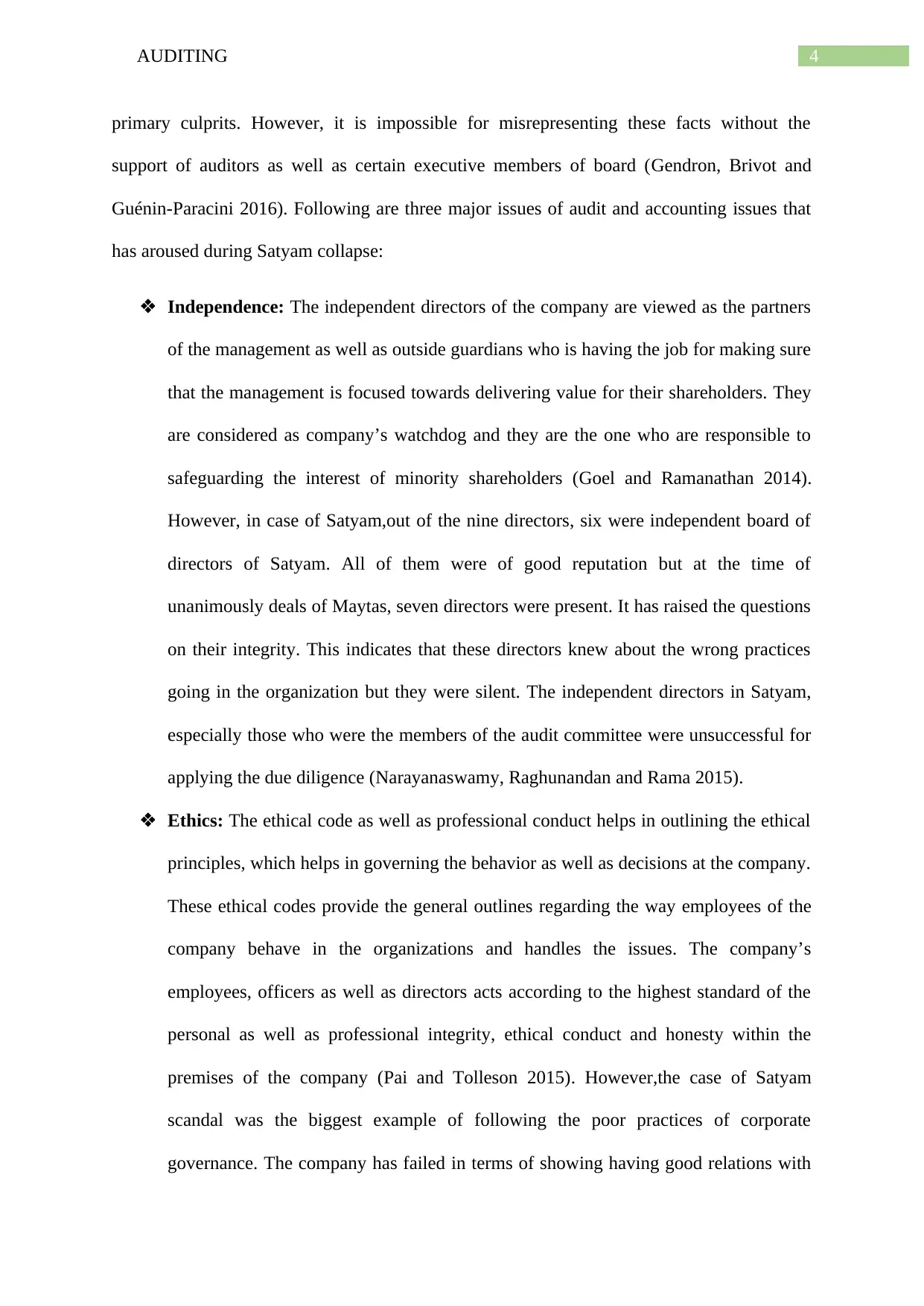
4AUDITING
primary culprits. However, it is impossible for misrepresenting these facts without the
support of auditors as well as certain executive members of board (Gendron, Brivot and
Guénin-Paracini 2016). Following are three major issues of audit and accounting issues that
has aroused during Satyam collapse:
Independence: The independent directors of the company are viewed as the partners
of the management as well as outside guardians who is having the job for making sure
that the management is focused towards delivering value for their shareholders. They
are considered as company’s watchdog and they are the one who are responsible to
safeguarding the interest of minority shareholders (Goel and Ramanathan 2014).
However, in case of Satyam,out of the nine directors, six were independent board of
directors of Satyam. All of them were of good reputation but at the time of
unanimously deals of Maytas, seven directors were present. It has raised the questions
on their integrity. This indicates that these directors knew about the wrong practices
going in the organization but they were silent. The independent directors in Satyam,
especially those who were the members of the audit committee were unsuccessful for
applying the due diligence (Narayanaswamy, Raghunandan and Rama 2015).
Ethics: The ethical code as well as professional conduct helps in outlining the ethical
principles, which helps in governing the behavior as well as decisions at the company.
These ethical codes provide the general outlines regarding the way employees of the
company behave in the organizations and handles the issues. The company’s
employees, officers as well as directors acts according to the highest standard of the
personal as well as professional integrity, ethical conduct and honesty within the
premises of the company (Pai and Tolleson 2015). However,the case of Satyam
scandal was the biggest example of following the poor practices of corporate
governance. The company has failed in terms of showing having good relations with
primary culprits. However, it is impossible for misrepresenting these facts without the
support of auditors as well as certain executive members of board (Gendron, Brivot and
Guénin-Paracini 2016). Following are three major issues of audit and accounting issues that
has aroused during Satyam collapse:
Independence: The independent directors of the company are viewed as the partners
of the management as well as outside guardians who is having the job for making sure
that the management is focused towards delivering value for their shareholders. They
are considered as company’s watchdog and they are the one who are responsible to
safeguarding the interest of minority shareholders (Goel and Ramanathan 2014).
However, in case of Satyam,out of the nine directors, six were independent board of
directors of Satyam. All of them were of good reputation but at the time of
unanimously deals of Maytas, seven directors were present. It has raised the questions
on their integrity. This indicates that these directors knew about the wrong practices
going in the organization but they were silent. The independent directors in Satyam,
especially those who were the members of the audit committee were unsuccessful for
applying the due diligence (Narayanaswamy, Raghunandan and Rama 2015).
Ethics: The ethical code as well as professional conduct helps in outlining the ethical
principles, which helps in governing the behavior as well as decisions at the company.
These ethical codes provide the general outlines regarding the way employees of the
company behave in the organizations and handles the issues. The company’s
employees, officers as well as directors acts according to the highest standard of the
personal as well as professional integrity, ethical conduct and honesty within the
premises of the company (Pai and Tolleson 2015). However,the case of Satyam
scandal was the biggest example of following the poor practices of corporate
governance. The company has failed in terms of showing having good relations with
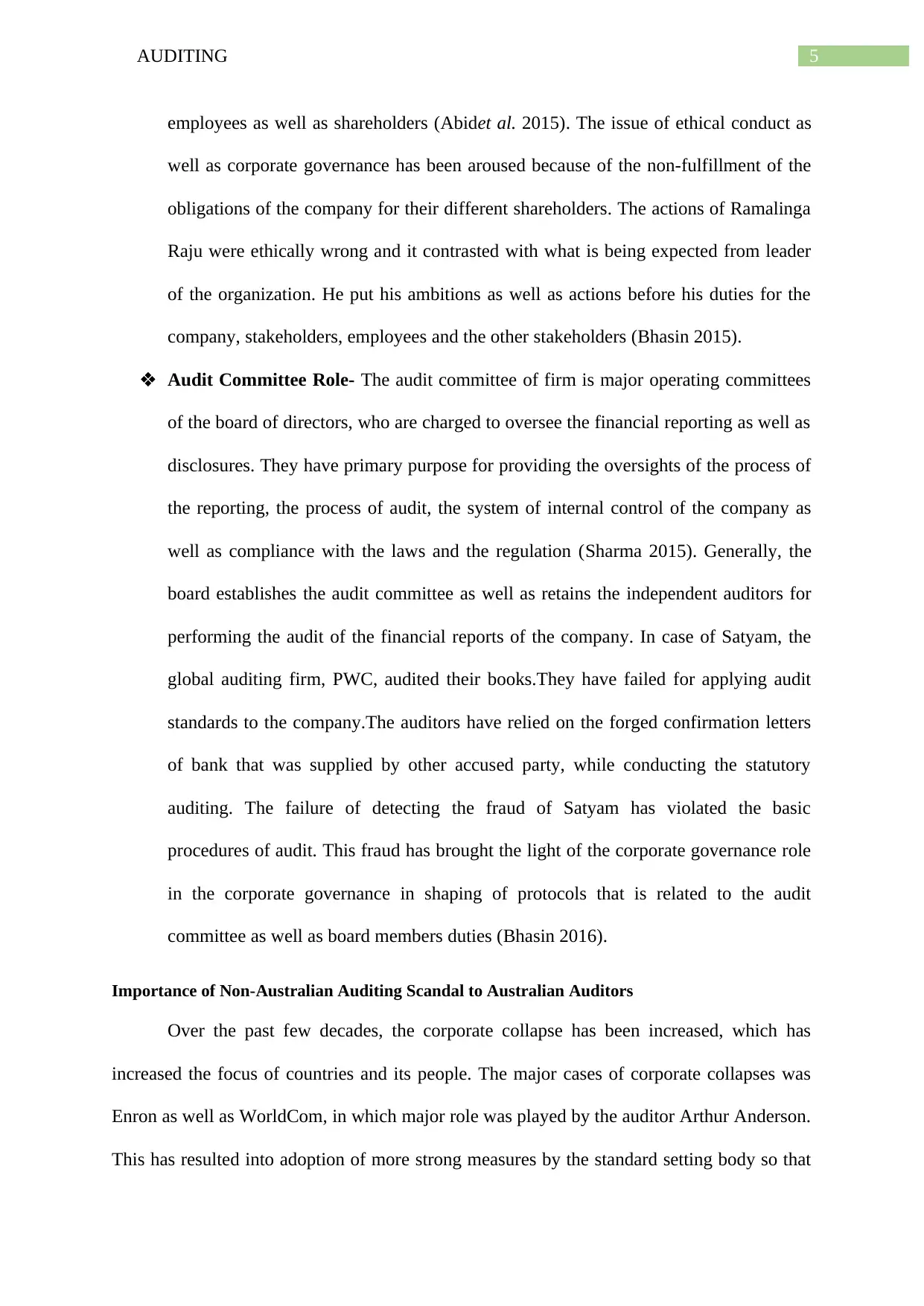
5AUDITING
employees as well as shareholders (Abidet al. 2015). The issue of ethical conduct as
well as corporate governance has been aroused because of the non-fulfillment of the
obligations of the company for their different shareholders. The actions of Ramalinga
Raju were ethically wrong and it contrasted with what is being expected from leader
of the organization. He put his ambitions as well as actions before his duties for the
company, stakeholders, employees and the other stakeholders (Bhasin 2015).
Audit Committee Role- The audit committee of firm is major operating committees
of the board of directors, who are charged to oversee the financial reporting as well as
disclosures. They have primary purpose for providing the oversights of the process of
the reporting, the process of audit, the system of internal control of the company as
well as compliance with the laws and the regulation (Sharma 2015). Generally, the
board establishes the audit committee as well as retains the independent auditors for
performing the audit of the financial reports of the company. In case of Satyam, the
global auditing firm, PWC, audited their books.They have failed for applying audit
standards to the company.The auditors have relied on the forged confirmation letters
of bank that was supplied by other accused party, while conducting the statutory
auditing. The failure of detecting the fraud of Satyam has violated the basic
procedures of audit. This fraud has brought the light of the corporate governance role
in the corporate governance in shaping of protocols that is related to the audit
committee as well as board members duties (Bhasin 2016).
Importance of Non-Australian Auditing Scandal to Australian Auditors
Over the past few decades, the corporate collapse has been increased, which has
increased the focus of countries and its people. The major cases of corporate collapses was
Enron as well as WorldCom, in which major role was played by the auditor Arthur Anderson.
This has resulted into adoption of more strong measures by the standard setting body so that
employees as well as shareholders (Abidet al. 2015). The issue of ethical conduct as
well as corporate governance has been aroused because of the non-fulfillment of the
obligations of the company for their different shareholders. The actions of Ramalinga
Raju were ethically wrong and it contrasted with what is being expected from leader
of the organization. He put his ambitions as well as actions before his duties for the
company, stakeholders, employees and the other stakeholders (Bhasin 2015).
Audit Committee Role- The audit committee of firm is major operating committees
of the board of directors, who are charged to oversee the financial reporting as well as
disclosures. They have primary purpose for providing the oversights of the process of
the reporting, the process of audit, the system of internal control of the company as
well as compliance with the laws and the regulation (Sharma 2015). Generally, the
board establishes the audit committee as well as retains the independent auditors for
performing the audit of the financial reports of the company. In case of Satyam, the
global auditing firm, PWC, audited their books.They have failed for applying audit
standards to the company.The auditors have relied on the forged confirmation letters
of bank that was supplied by other accused party, while conducting the statutory
auditing. The failure of detecting the fraud of Satyam has violated the basic
procedures of audit. This fraud has brought the light of the corporate governance role
in the corporate governance in shaping of protocols that is related to the audit
committee as well as board members duties (Bhasin 2016).
Importance of Non-Australian Auditing Scandal to Australian Auditors
Over the past few decades, the corporate collapse has been increased, which has
increased the focus of countries and its people. The major cases of corporate collapses was
Enron as well as WorldCom, in which major role was played by the auditor Arthur Anderson.
This has resulted into adoption of more strong measures by the standard setting body so that
⊘ This is a preview!⊘
Do you want full access?
Subscribe today to unlock all pages.

Trusted by 1+ million students worldwide
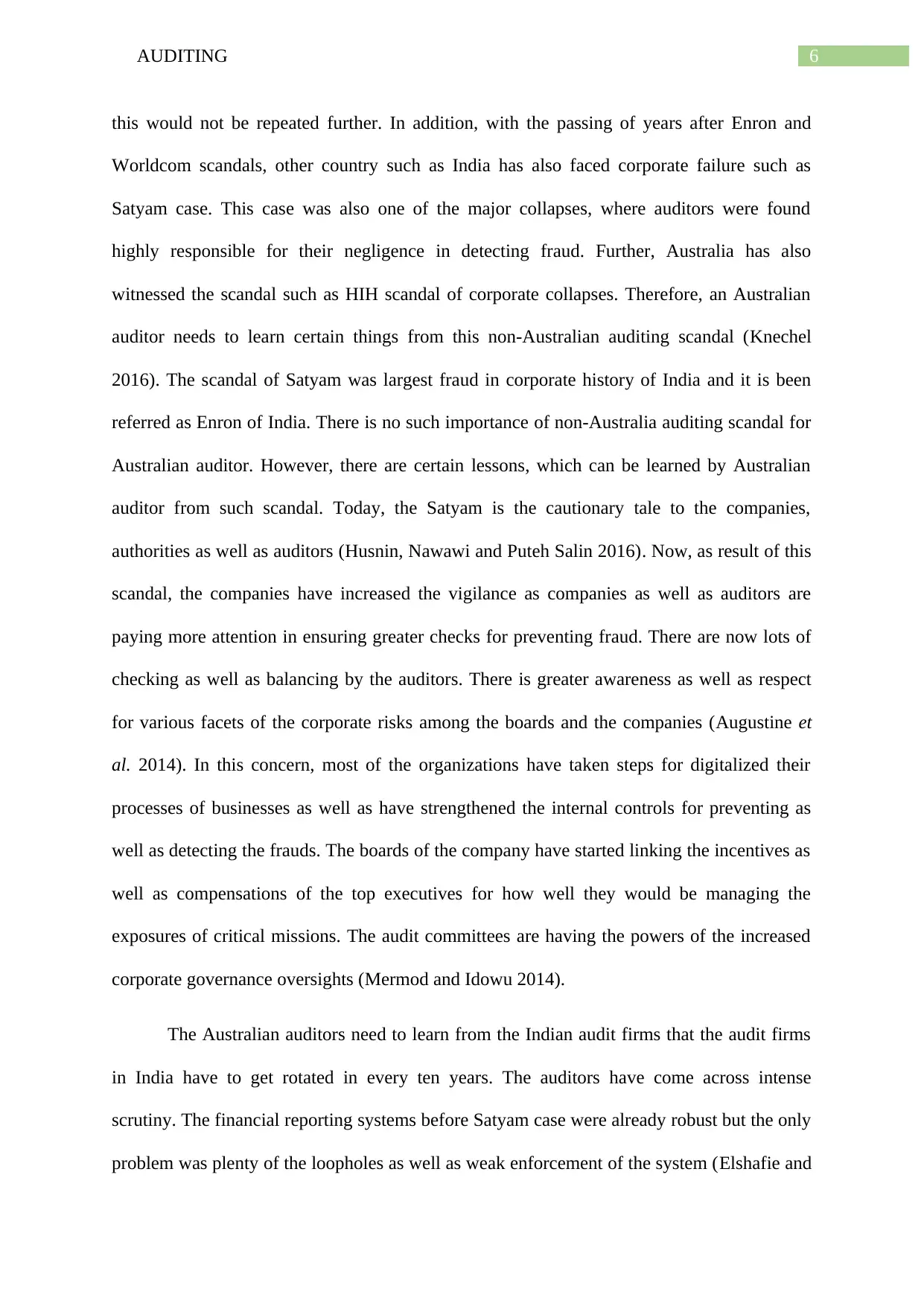
6AUDITING
this would not be repeated further. In addition, with the passing of years after Enron and
Worldcom scandals, other country such as India has also faced corporate failure such as
Satyam case. This case was also one of the major collapses, where auditors were found
highly responsible for their negligence in detecting fraud. Further, Australia has also
witnessed the scandal such as HIH scandal of corporate collapses. Therefore, an Australian
auditor needs to learn certain things from this non-Australian auditing scandal (Knechel
2016). The scandal of Satyam was largest fraud in corporate history of India and it is been
referred as Enron of India. There is no such importance of non-Australia auditing scandal for
Australian auditor. However, there are certain lessons, which can be learned by Australian
auditor from such scandal. Today, the Satyam is the cautionary tale to the companies,
authorities as well as auditors (Husnin, Nawawi and Puteh Salin 2016). Now, as result of this
scandal, the companies have increased the vigilance as companies as well as auditors are
paying more attention in ensuring greater checks for preventing fraud. There are now lots of
checking as well as balancing by the auditors. There is greater awareness as well as respect
for various facets of the corporate risks among the boards and the companies (Augustine et
al. 2014). In this concern, most of the organizations have taken steps for digitalized their
processes of businesses as well as have strengthened the internal controls for preventing as
well as detecting the frauds. The boards of the company have started linking the incentives as
well as compensations of the top executives for how well they would be managing the
exposures of critical missions. The audit committees are having the powers of the increased
corporate governance oversights (Mermod and Idowu 2014).
The Australian auditors need to learn from the Indian audit firms that the audit firms
in India have to get rotated in every ten years. The auditors have come across intense
scrutiny. The financial reporting systems before Satyam case were already robust but the only
problem was plenty of the loopholes as well as weak enforcement of the system (Elshafie and
this would not be repeated further. In addition, with the passing of years after Enron and
Worldcom scandals, other country such as India has also faced corporate failure such as
Satyam case. This case was also one of the major collapses, where auditors were found
highly responsible for their negligence in detecting fraud. Further, Australia has also
witnessed the scandal such as HIH scandal of corporate collapses. Therefore, an Australian
auditor needs to learn certain things from this non-Australian auditing scandal (Knechel
2016). The scandal of Satyam was largest fraud in corporate history of India and it is been
referred as Enron of India. There is no such importance of non-Australia auditing scandal for
Australian auditor. However, there are certain lessons, which can be learned by Australian
auditor from such scandal. Today, the Satyam is the cautionary tale to the companies,
authorities as well as auditors (Husnin, Nawawi and Puteh Salin 2016). Now, as result of this
scandal, the companies have increased the vigilance as companies as well as auditors are
paying more attention in ensuring greater checks for preventing fraud. There are now lots of
checking as well as balancing by the auditors. There is greater awareness as well as respect
for various facets of the corporate risks among the boards and the companies (Augustine et
al. 2014). In this concern, most of the organizations have taken steps for digitalized their
processes of businesses as well as have strengthened the internal controls for preventing as
well as detecting the frauds. The boards of the company have started linking the incentives as
well as compensations of the top executives for how well they would be managing the
exposures of critical missions. The audit committees are having the powers of the increased
corporate governance oversights (Mermod and Idowu 2014).
The Australian auditors need to learn from the Indian audit firms that the audit firms
in India have to get rotated in every ten years. The auditors have come across intense
scrutiny. The financial reporting systems before Satyam case were already robust but the only
problem was plenty of the loopholes as well as weak enforcement of the system (Elshafie and
Paraphrase This Document
Need a fresh take? Get an instant paraphrase of this document with our AI Paraphraser
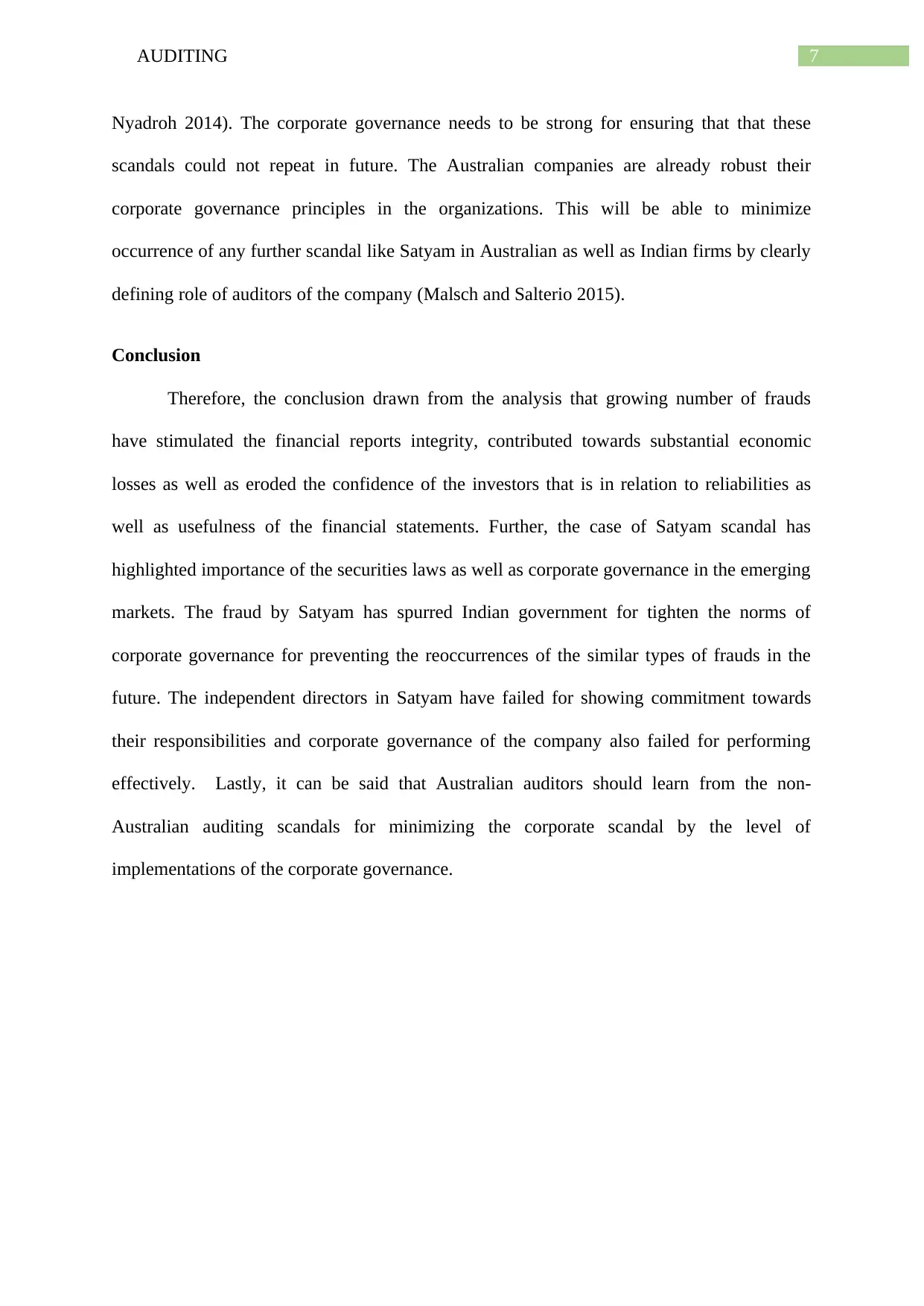
7AUDITING
Nyadroh 2014). The corporate governance needs to be strong for ensuring that that these
scandals could not repeat in future. The Australian companies are already robust their
corporate governance principles in the organizations. This will be able to minimize
occurrence of any further scandal like Satyam in Australian as well as Indian firms by clearly
defining role of auditors of the company (Malsch and Salterio 2015).
Conclusion
Therefore, the conclusion drawn from the analysis that growing number of frauds
have stimulated the financial reports integrity, contributed towards substantial economic
losses as well as eroded the confidence of the investors that is in relation to reliabilities as
well as usefulness of the financial statements. Further, the case of Satyam scandal has
highlighted importance of the securities laws as well as corporate governance in the emerging
markets. The fraud by Satyam has spurred Indian government for tighten the norms of
corporate governance for preventing the reoccurrences of the similar types of frauds in the
future. The independent directors in Satyam have failed for showing commitment towards
their responsibilities and corporate governance of the company also failed for performing
effectively. Lastly, it can be said that Australian auditors should learn from the non-
Australian auditing scandals for minimizing the corporate scandal by the level of
implementations of the corporate governance.
Nyadroh 2014). The corporate governance needs to be strong for ensuring that that these
scandals could not repeat in future. The Australian companies are already robust their
corporate governance principles in the organizations. This will be able to minimize
occurrence of any further scandal like Satyam in Australian as well as Indian firms by clearly
defining role of auditors of the company (Malsch and Salterio 2015).
Conclusion
Therefore, the conclusion drawn from the analysis that growing number of frauds
have stimulated the financial reports integrity, contributed towards substantial economic
losses as well as eroded the confidence of the investors that is in relation to reliabilities as
well as usefulness of the financial statements. Further, the case of Satyam scandal has
highlighted importance of the securities laws as well as corporate governance in the emerging
markets. The fraud by Satyam has spurred Indian government for tighten the norms of
corporate governance for preventing the reoccurrences of the similar types of frauds in the
future. The independent directors in Satyam have failed for showing commitment towards
their responsibilities and corporate governance of the company also failed for performing
effectively. Lastly, it can be said that Australian auditors should learn from the non-
Australian auditing scandals for minimizing the corporate scandal by the level of
implementations of the corporate governance.
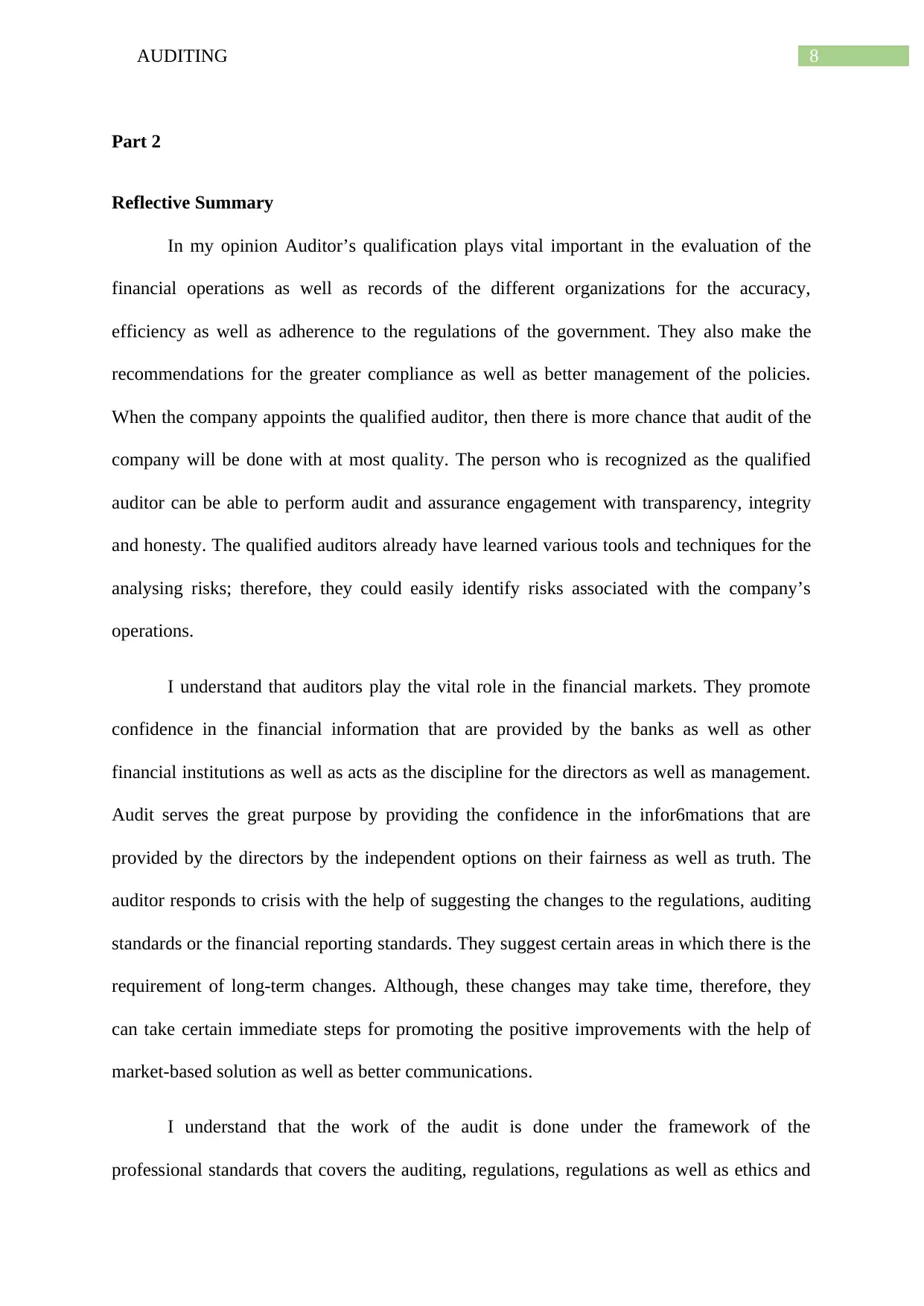
8AUDITING
Part 2
Reflective Summary
In my opinion Auditor’s qualification plays vital important in the evaluation of the
financial operations as well as records of the different organizations for the accuracy,
efficiency as well as adherence to the regulations of the government. They also make the
recommendations for the greater compliance as well as better management of the policies.
When the company appoints the qualified auditor, then there is more chance that audit of the
company will be done with at most quality. The person who is recognized as the qualified
auditor can be able to perform audit and assurance engagement with transparency, integrity
and honesty. The qualified auditors already have learned various tools and techniques for the
analysing risks; therefore, they could easily identify risks associated with the company’s
operations.
I understand that auditors play the vital role in the financial markets. They promote
confidence in the financial information that are provided by the banks as well as other
financial institutions as well as acts as the discipline for the directors as well as management.
Audit serves the great purpose by providing the confidence in the infor6mations that are
provided by the directors by the independent options on their fairness as well as truth. The
auditor responds to crisis with the help of suggesting the changes to the regulations, auditing
standards or the financial reporting standards. They suggest certain areas in which there is the
requirement of long-term changes. Although, these changes may take time, therefore, they
can take certain immediate steps for promoting the positive improvements with the help of
market-based solution as well as better communications.
I understand that the work of the audit is done under the framework of the
professional standards that covers the auditing, regulations, regulations as well as ethics and
Part 2
Reflective Summary
In my opinion Auditor’s qualification plays vital important in the evaluation of the
financial operations as well as records of the different organizations for the accuracy,
efficiency as well as adherence to the regulations of the government. They also make the
recommendations for the greater compliance as well as better management of the policies.
When the company appoints the qualified auditor, then there is more chance that audit of the
company will be done with at most quality. The person who is recognized as the qualified
auditor can be able to perform audit and assurance engagement with transparency, integrity
and honesty. The qualified auditors already have learned various tools and techniques for the
analysing risks; therefore, they could easily identify risks associated with the company’s
operations.
I understand that auditors play the vital role in the financial markets. They promote
confidence in the financial information that are provided by the banks as well as other
financial institutions as well as acts as the discipline for the directors as well as management.
Audit serves the great purpose by providing the confidence in the infor6mations that are
provided by the directors by the independent options on their fairness as well as truth. The
auditor responds to crisis with the help of suggesting the changes to the regulations, auditing
standards or the financial reporting standards. They suggest certain areas in which there is the
requirement of long-term changes. Although, these changes may take time, therefore, they
can take certain immediate steps for promoting the positive improvements with the help of
market-based solution as well as better communications.
I understand that the work of the audit is done under the framework of the
professional standards that covers the auditing, regulations, regulations as well as ethics and
⊘ This is a preview!⊘
Do you want full access?
Subscribe today to unlock all pages.

Trusted by 1+ million students worldwide
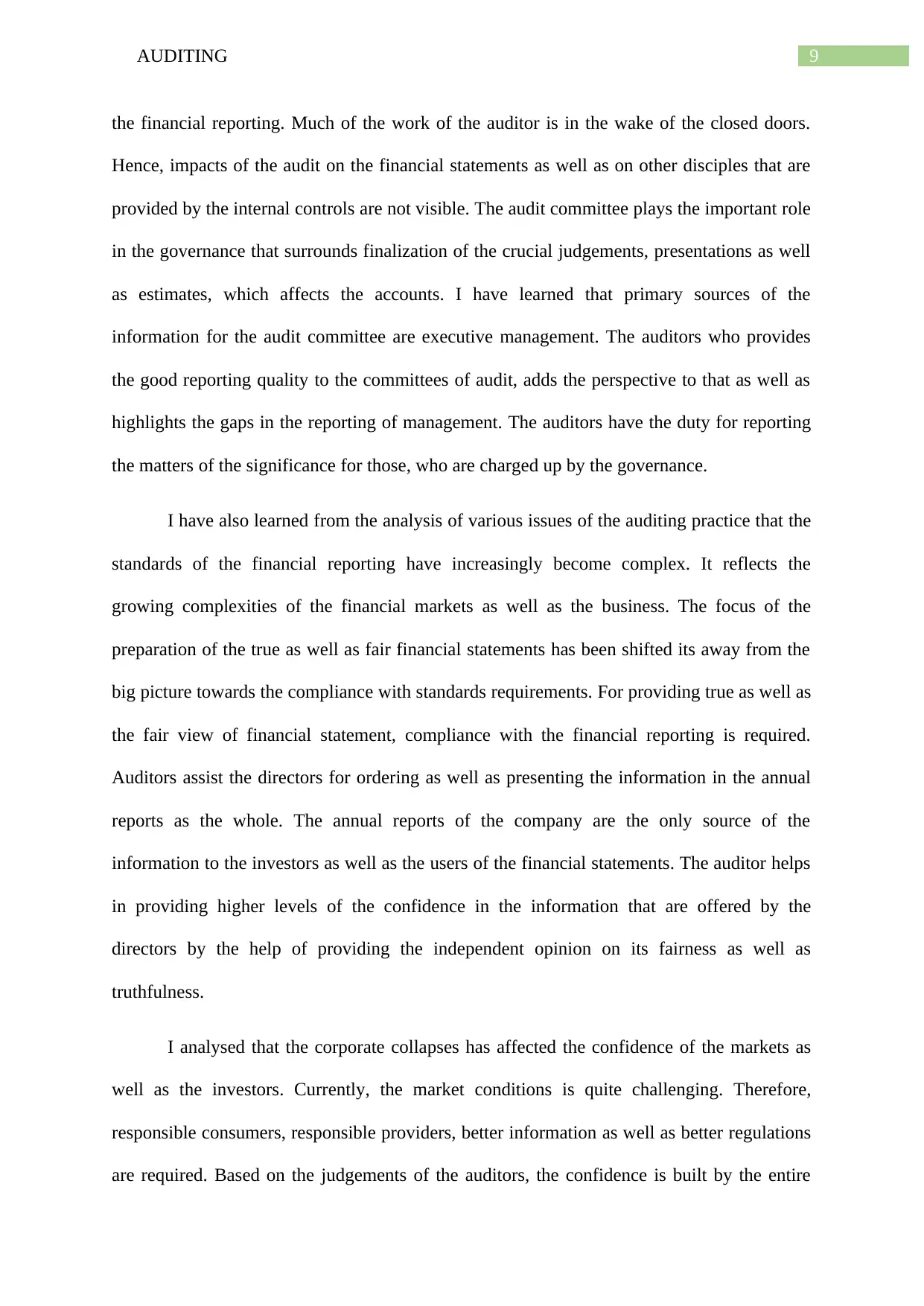
9AUDITING
the financial reporting. Much of the work of the auditor is in the wake of the closed doors.
Hence, impacts of the audit on the financial statements as well as on other disciples that are
provided by the internal controls are not visible. The audit committee plays the important role
in the governance that surrounds finalization of the crucial judgements, presentations as well
as estimates, which affects the accounts. I have learned that primary sources of the
information for the audit committee are executive management. The auditors who provides
the good reporting quality to the committees of audit, adds the perspective to that as well as
highlights the gaps in the reporting of management. The auditors have the duty for reporting
the matters of the significance for those, who are charged up by the governance.
I have also learned from the analysis of various issues of the auditing practice that the
standards of the financial reporting have increasingly become complex. It reflects the
growing complexities of the financial markets as well as the business. The focus of the
preparation of the true as well as fair financial statements has been shifted its away from the
big picture towards the compliance with standards requirements. For providing true as well as
the fair view of financial statement, compliance with the financial reporting is required.
Auditors assist the directors for ordering as well as presenting the information in the annual
reports as the whole. The annual reports of the company are the only source of the
information to the investors as well as the users of the financial statements. The auditor helps
in providing higher levels of the confidence in the information that are offered by the
directors by the help of providing the independent opinion on its fairness as well as
truthfulness.
I analysed that the corporate collapses has affected the confidence of the markets as
well as the investors. Currently, the market conditions is quite challenging. Therefore,
responsible consumers, responsible providers, better information as well as better regulations
are required. Based on the judgements of the auditors, the confidence is built by the entire
the financial reporting. Much of the work of the auditor is in the wake of the closed doors.
Hence, impacts of the audit on the financial statements as well as on other disciples that are
provided by the internal controls are not visible. The audit committee plays the important role
in the governance that surrounds finalization of the crucial judgements, presentations as well
as estimates, which affects the accounts. I have learned that primary sources of the
information for the audit committee are executive management. The auditors who provides
the good reporting quality to the committees of audit, adds the perspective to that as well as
highlights the gaps in the reporting of management. The auditors have the duty for reporting
the matters of the significance for those, who are charged up by the governance.
I have also learned from the analysis of various issues of the auditing practice that the
standards of the financial reporting have increasingly become complex. It reflects the
growing complexities of the financial markets as well as the business. The focus of the
preparation of the true as well as fair financial statements has been shifted its away from the
big picture towards the compliance with standards requirements. For providing true as well as
the fair view of financial statement, compliance with the financial reporting is required.
Auditors assist the directors for ordering as well as presenting the information in the annual
reports as the whole. The annual reports of the company are the only source of the
information to the investors as well as the users of the financial statements. The auditor helps
in providing higher levels of the confidence in the information that are offered by the
directors by the help of providing the independent opinion on its fairness as well as
truthfulness.
I analysed that the corporate collapses has affected the confidence of the markets as
well as the investors. Currently, the market conditions is quite challenging. Therefore,
responsible consumers, responsible providers, better information as well as better regulations
are required. Based on the judgements of the auditors, the confidence is built by the entire
Paraphrase This Document
Need a fresh take? Get an instant paraphrase of this document with our AI Paraphraser
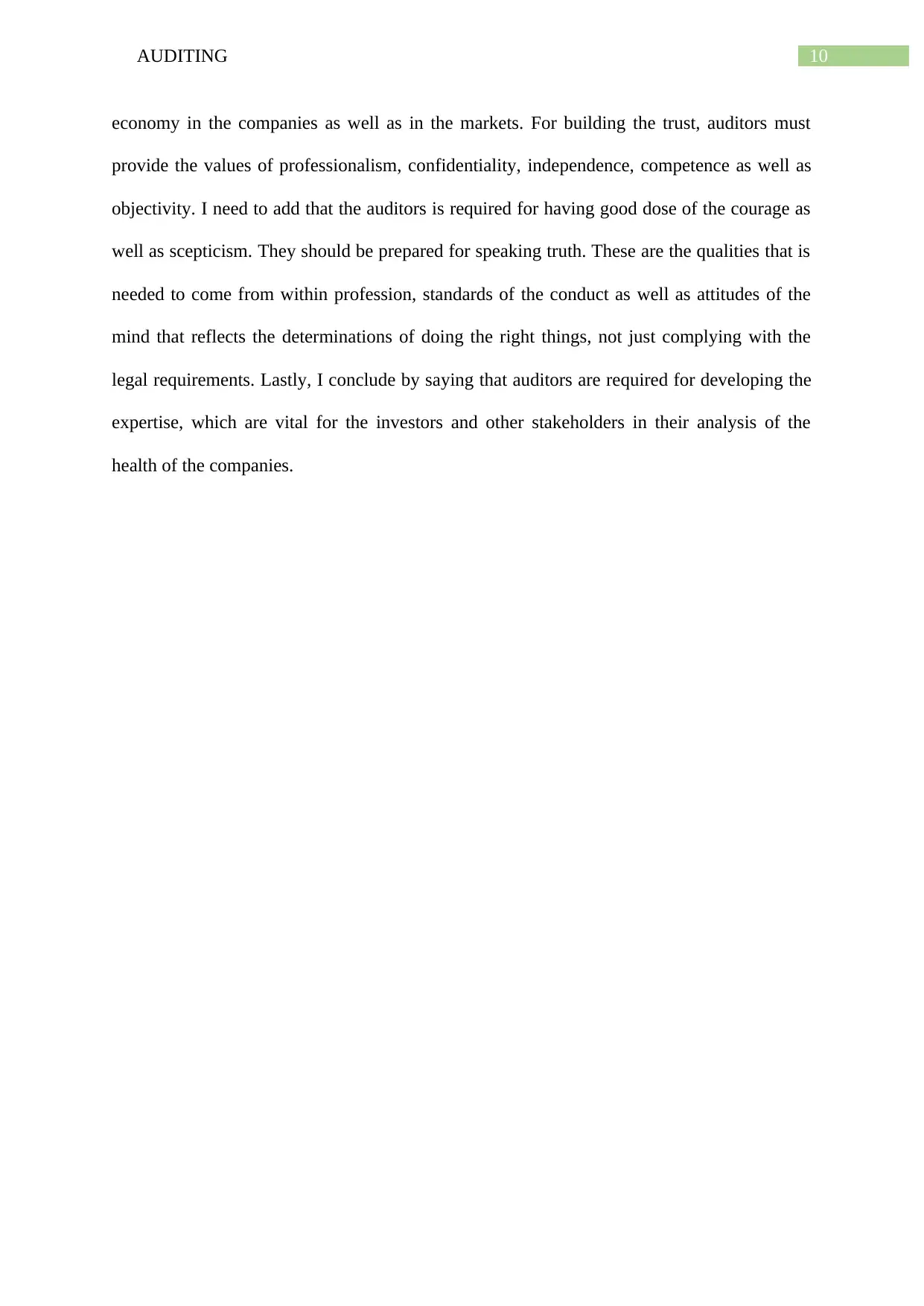
10AUDITING
economy in the companies as well as in the markets. For building the trust, auditors must
provide the values of professionalism, confidentiality, independence, competence as well as
objectivity. I need to add that the auditors is required for having good dose of the courage as
well as scepticism. They should be prepared for speaking truth. These are the qualities that is
needed to come from within profession, standards of the conduct as well as attitudes of the
mind that reflects the determinations of doing the right things, not just complying with the
legal requirements. Lastly, I conclude by saying that auditors are required for developing the
expertise, which are vital for the investors and other stakeholders in their analysis of the
health of the companies.
economy in the companies as well as in the markets. For building the trust, auditors must
provide the values of professionalism, confidentiality, independence, competence as well as
objectivity. I need to add that the auditors is required for having good dose of the courage as
well as scepticism. They should be prepared for speaking truth. These are the qualities that is
needed to come from within profession, standards of the conduct as well as attitudes of the
mind that reflects the determinations of doing the right things, not just complying with the
legal requirements. Lastly, I conclude by saying that auditors are required for developing the
expertise, which are vital for the investors and other stakeholders in their analysis of the
health of the companies.
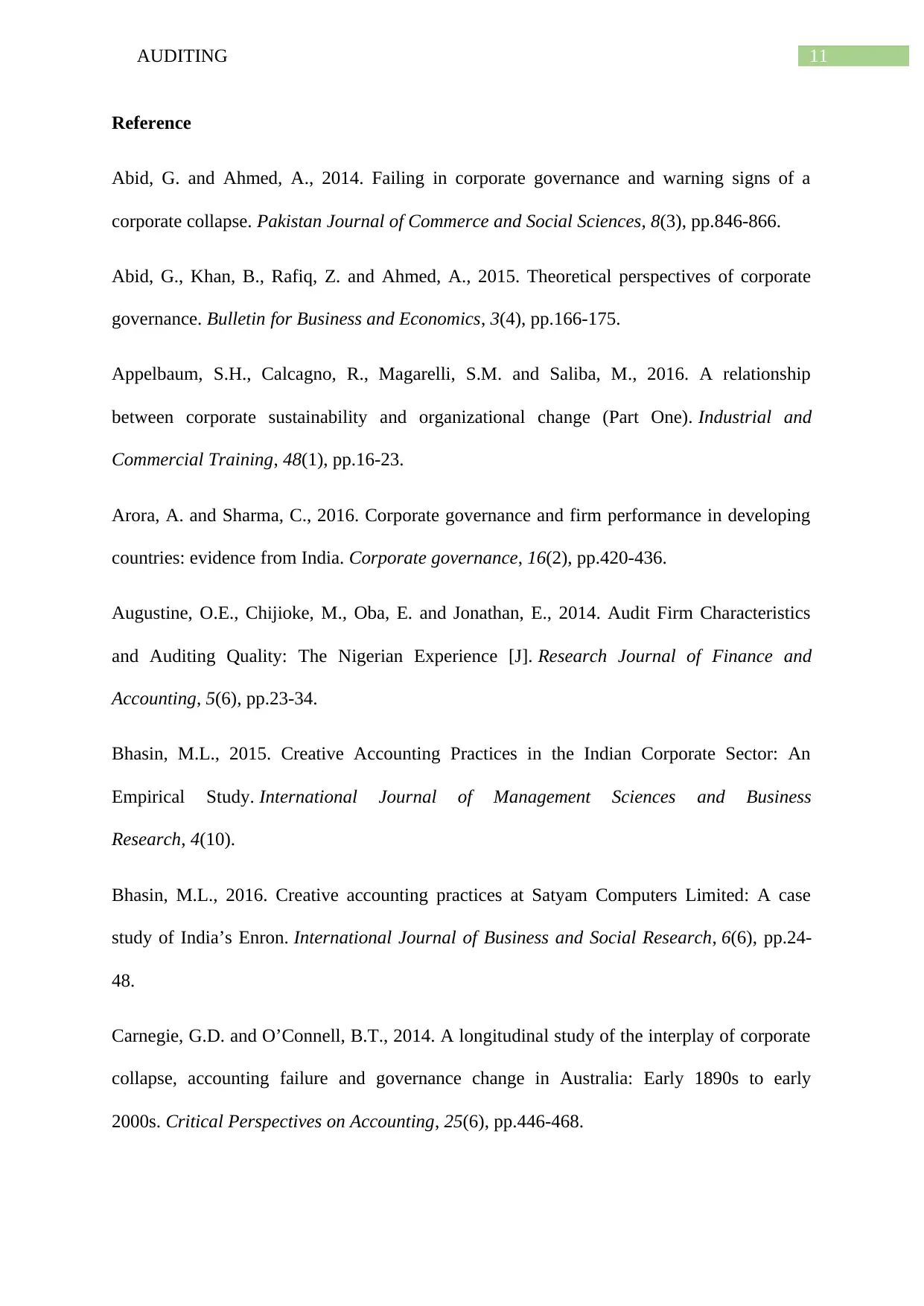
11AUDITING
Reference
Abid, G. and Ahmed, A., 2014. Failing in corporate governance and warning signs of a
corporate collapse. Pakistan Journal of Commerce and Social Sciences, 8(3), pp.846-866.
Abid, G., Khan, B., Rafiq, Z. and Ahmed, A., 2015. Theoretical perspectives of corporate
governance. Bulletin for Business and Economics, 3(4), pp.166-175.
Appelbaum, S.H., Calcagno, R., Magarelli, S.M. and Saliba, M., 2016. A relationship
between corporate sustainability and organizational change (Part One). Industrial and
Commercial Training, 48(1), pp.16-23.
Arora, A. and Sharma, C., 2016. Corporate governance and firm performance in developing
countries: evidence from India. Corporate governance, 16(2), pp.420-436.
Augustine, O.E., Chijioke, M., Oba, E. and Jonathan, E., 2014. Audit Firm Characteristics
and Auditing Quality: The Nigerian Experience [J]. Research Journal of Finance and
Accounting, 5(6), pp.23-34.
Bhasin, M.L., 2015. Creative Accounting Practices in the Indian Corporate Sector: An
Empirical Study. International Journal of Management Sciences and Business
Research, 4(10).
Bhasin, M.L., 2016. Creative accounting practices at Satyam Computers Limited: A case
study of India’s Enron. International Journal of Business and Social Research, 6(6), pp.24-
48.
Carnegie, G.D. and O’Connell, B.T., 2014. A longitudinal study of the interplay of corporate
collapse, accounting failure and governance change in Australia: Early 1890s to early
2000s. Critical Perspectives on Accounting, 25(6), pp.446-468.
Reference
Abid, G. and Ahmed, A., 2014. Failing in corporate governance and warning signs of a
corporate collapse. Pakistan Journal of Commerce and Social Sciences, 8(3), pp.846-866.
Abid, G., Khan, B., Rafiq, Z. and Ahmed, A., 2015. Theoretical perspectives of corporate
governance. Bulletin for Business and Economics, 3(4), pp.166-175.
Appelbaum, S.H., Calcagno, R., Magarelli, S.M. and Saliba, M., 2016. A relationship
between corporate sustainability and organizational change (Part One). Industrial and
Commercial Training, 48(1), pp.16-23.
Arora, A. and Sharma, C., 2016. Corporate governance and firm performance in developing
countries: evidence from India. Corporate governance, 16(2), pp.420-436.
Augustine, O.E., Chijioke, M., Oba, E. and Jonathan, E., 2014. Audit Firm Characteristics
and Auditing Quality: The Nigerian Experience [J]. Research Journal of Finance and
Accounting, 5(6), pp.23-34.
Bhasin, M.L., 2015. Creative Accounting Practices in the Indian Corporate Sector: An
Empirical Study. International Journal of Management Sciences and Business
Research, 4(10).
Bhasin, M.L., 2016. Creative accounting practices at Satyam Computers Limited: A case
study of India’s Enron. International Journal of Business and Social Research, 6(6), pp.24-
48.
Carnegie, G.D. and O’Connell, B.T., 2014. A longitudinal study of the interplay of corporate
collapse, accounting failure and governance change in Australia: Early 1890s to early
2000s. Critical Perspectives on Accounting, 25(6), pp.446-468.
⊘ This is a preview!⊘
Do you want full access?
Subscribe today to unlock all pages.

Trusted by 1+ million students worldwide
1 out of 14
Related Documents
Your All-in-One AI-Powered Toolkit for Academic Success.
+13062052269
info@desklib.com
Available 24*7 on WhatsApp / Email
![[object Object]](/_next/static/media/star-bottom.7253800d.svg)
Unlock your academic potential
Copyright © 2020–2025 A2Z Services. All Rights Reserved. Developed and managed by ZUCOL.





